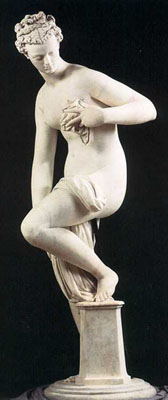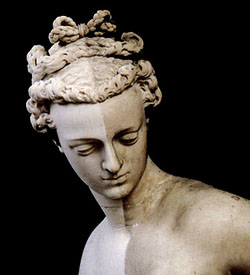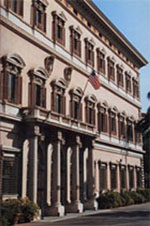
Giambologna's Cesarini Venus, now in the
Lobby
of the US Embassy in Rome
 |
Giambologna's Cesarini Venus, now in the
Lobby
|
After you walk through the security area, take a really sharp left turn and go out the wooden doors into the courtyard of Palazzo Margherita, the American Embassy here in Rome. Move forward about ten steps -- right to the middle, among the pillars -- and turn ninety degrees right. In front of you will be the lofty glass doors that open into a small lobby surrounded by the Grand Staircase leading up to the Palazzo's piano nobile, the "noble floor", on which the Royals received their guests and had their apartments. In the wall over the middle section of the stairway, directly opposite the glass doors but much, much higher, is a niche, which, unlike the others around the staircase, is starkly empty. But why would your eyes stray upward to this emptiness when its former occupant, Giambologna's Cesarini Venus, stands before you in her glory, at ground level.
In her niche she was less than glorious: hard to see, dirty, neglected, and, the greatest insult, long misidentified as a copy. You never would have known that she was the masterpiece of feminine form, the culmination of the study of that subject by the most famous sculptor of his day.
What? Never heard of Giambologna? Even if you haven't you are almost sure to be familiar with one of his works, the famous "Flying Mercury" (http://www.thais.it/scultura/sch00301.htm) with winged sandals and helmet. It is included in the corporate logos of countless large and small delivery and messenger services: Mercury (Hermes in Greek myth) was, after all, the messenger god. But any art-aware person of the 16th century (or any student of sculpture, even until today) would know that Giambologna was the best of his generation and the sculptor of choice of the Medici. They would know also that he produced numerous great sculptures.
Today he might be considered a Frenchman, and the French are quick to claim him as one of "their" great artists even though all of his work was done while he lived in Italy. Born Jean Boulogne in 1529 in the town of Douai in Flanders, which was then part of the Spanish Netherlands, he studied under Jaques Dubroeucq in Mons starting in 1544. Jean traveled to Rome in 1550 to study classical art, making clay and wax models of what he saw. It was these models that impressed a Florentine art connoisseur three years later, in 1553, as Jean was passing through the city on his route back to France. Bernardo Vecchetti offered Jean lodging, a studio, and, most importantly, good marble to carve, if only he would stay in Florence. From the first block of marble, Giambologna, as he quickly came to be known, carved the first of his magnificent female nudes (-- it's now, unfortunately, lost). Soon thereafter, Vecchetti introduced the artist to Prince Francesco de' Medici, and the Medici took over the patronage.
Giambologna stayed in Italy working for the Medici for the rest of his life. Before he died in 1608, he had carved many famous works including a series of female nudes in marble (and miniatures of them in bronze) as well as monumental groups and bas reliefs. They still grace public squares in Italy and all of Italy's and the world's great museums. (See http://www.thais.it/scultura/gianbolo.htm for what is in Florence, http://www.artcyclopedia.com/artists/giambologna.html for what is elsewhere, and http://bertie.vam.ac.uk/exploring/galleries/european_art/mannerism/?view=Fullscreen_top&image=popup_image1&caption=thumbnail_image_caption1 for the famous Samson in London's Victoria and Albert). Some of his sculpture is in the private collections of the ultra-rich.
Giambologna often cast multiple copies of his bronzes, especially the miniatures, but also of some of the full-scale works -- there are four known iterations of the Mercury mentioned above, the first dating from 1550. He worked closely with Antonio Susini, the master Florentine bronze caster of his day, allowing Susini to continue casting replicas even after he had left Giambologna's employ and set up his own workshop (around 1600). The small Susini castings still command very high prices from museums and collectors today -- a ten inch "pacing bull" cast by Susini went to a private collector at Sothebys a year ago for almost $470 thousand. Massimiliano Soldati-Benzi (1656-1740) cast another fine series of replicas, and they, also, command respectable prices and have been thought worthy of museum display. It wasn’t long, however, before lesser artists were also producing copies of the bronzes. Some of them were done by hand, but others were simply made by casting from molds made from Giambologna/Susini/Soldati-Benzi works. Some of these would now be considered "licensed", but many were just pirate copies. Whether they were from the Giambologna/Susini foundries or from elsewhere, and legitimate or not, Giambologna's work and the copies soon became so widespread and standard that it has rightly been said that Giambologna was almost single-handedly responsible for the spread of "mannerist" sculpture in succeeding generations.
Giambologna was at the height of his powers and his fame when, in 1583, he produced the Cesarini Venus that now stands in the lobby of the US Embassy in Rome. By that time he had been working in Florence for thirty years and had already produced more than enough for a lifetime (but he still had twenty-five more years) including his marble female nudes.
Ten years earlier he had carved another Venus for Prince Francesco de' Medici, which is now called the Grotticella Venus, because, since 1592 when Francesco died, it has been displayed in the "Grotticella" ("small grotto") in the family's Boboli Gardens in Florence. Although it was soon revered as "the most perfect female nude ever carved", Giambologna was himself dissatisfied with this earlier work and petitioned Francesco to let him re-cut it. Francesco refused.
Giambologna made another effort with the Cesarini Venus, and it turned out to be his last statue of a single female nude. It, like the Grotticella Venus, was commissioned by Francesco de' Medici, by then Grand Duke Francesco, and it was carved as a gift from Francesco to Giangiorgio Cesarini. It's not clear why the gift was given, but the statue was soon installed in the garden of the old Cesarini Palace on the Esquiline hill in Rome and has since been known as the Cesarini Venus. Within five years, it was reported to have been stolen (a crane over the wall in the night), but it was soon recovered. It may have been dropped during the theft or subsequently. At some point, it was broken into at least seven parts, and the repairs, still visible, but only if you look for them, date from about that time.
At any rate, the repairs had been accomplished and a new, broader base and the wrought iron supporting rod in the rear had probably been added by the time Cardinal Ludovico Ludovisi had the statue installed in his "Casino dell'Aurora" in 1622 (or 1623) -- the proportions of it's new base match those of the base of Christoforo Stati's Cleopatra with which it was displayed in the Casino. Ludovico had acquired the Venus after it had passed through three generations of Cesarini hands: Giangiorgio 2 gave most of his grandfather's collection to Ludovico, probably to gain favor with the new papal family. The Casino dell'Aurora, of course, was on the grounds of Villa Ludovisi, part of which eventually became the American Embassy. ("Villa" refers to the entire grounds and all its buildings rather than just to a single building.)
The Villa Ludovisi descended through the Ludovisi line and eventually, in 1699, was settled on Ippolita Ludovisi, who had married Gregorio Boncompagni. From then on, the Villa and its art belonged to the Boncompagni-Ludovisi line. By the early 18th century both of the statues had been moved from the main room of the Casino to the other great building of the Villa, the Palazzo Grande (also known as Palazzo Piombino, after another of the titles earlier acquired by the Ludovisi).
After the re-unification of Italy in 1870, large parts of the Villa were sold, but the Palazzo Grande and its contents stayed in the family. Prince Rudolfo Boncompagni-Ludovisi commissioned the architect Gaetano Koch (who also made the two palaces that make the hemi-cycle of Piazza della Repubblica) to build the addition and new façade facing onto the modern Via Veneto. It was at this point that the Cesarini Venus went into its almost inaccessible niche above the Grand Staircase.
The Prince, however, did not realize the great profits he had expected from the dismemberment of the Villa, and in 1892, just two years after it was completed, his financial obligations forced him to sell the Palazzo to the Banca d'Italia. The Venus conveyed with the sale. Other artwork was sold, mostly to the Italian Government, and much found its way to the Museo delle Terme (and can still be seen in the collections at several venues of the National Museum in Rome).
After the assassination of King Umberto 1 in 1900, the Italian royal family bought the Palazzo as a residence for his widow, the greatly respected Queen Margherita, and it has since been known as Palazzo Margherita. In 1946, the property was acquired by the US Government to be its embassy to the Italian Republic. Thus, the Cesarini Venus, still in its high niche and not recognized for what it was, became the property of the US government.
The Cesarini Venus stayed above the staircase until 1992 when, through the efforts of Enrico Bruschini, the Embassy's Fine Arts Curator at the time, it was finally identified as a Giambologna original. It was brought down, cleaned, and readied for display where it stands now. But first, its triumph was made complete by being exhibited in 1993 at the Capitoline Museum in Rome and in 1993-'94 at the National Gallery of Art in Washington, DC.
 TheVenus while in restoration, 1992
TheVenus while in restoration, 1992
The Venus is illuminated every night so that
it
can be seen from the Via Veneto.
|
|
 |
There is virtually nothing on the Internet about the Cesarini Venus. A few copies of the brochure from the 1993 - '94 National Gallery Exhibition are available for perusal in the Community Liaison Office of the American Embassy in Rome. Details of the history of the Venus are included in books on Giambologna and his works, which are available in better Rome bookstores and from online booksellers -- the Charles Avery book Giambologna: The Complete Sculpture has some coverage and a plate of the Cesarini Venus.
P.S.: Yet another preachy reminder: no book or Internet site can compete with the original works. Links above point to some good illustrations, but they are really mostly meant to tell you where to go to see the originals.
Go to http://www.mmdtkw.org/Veneto2002.html for other articles.